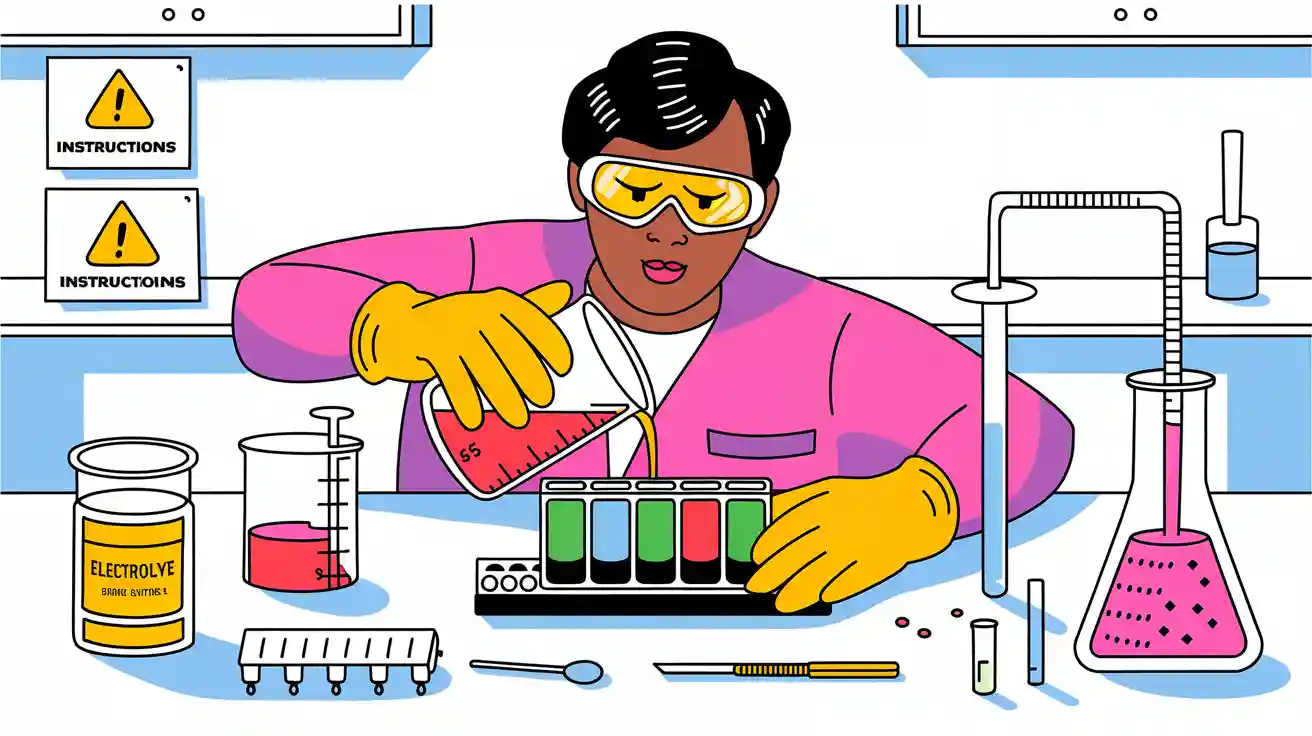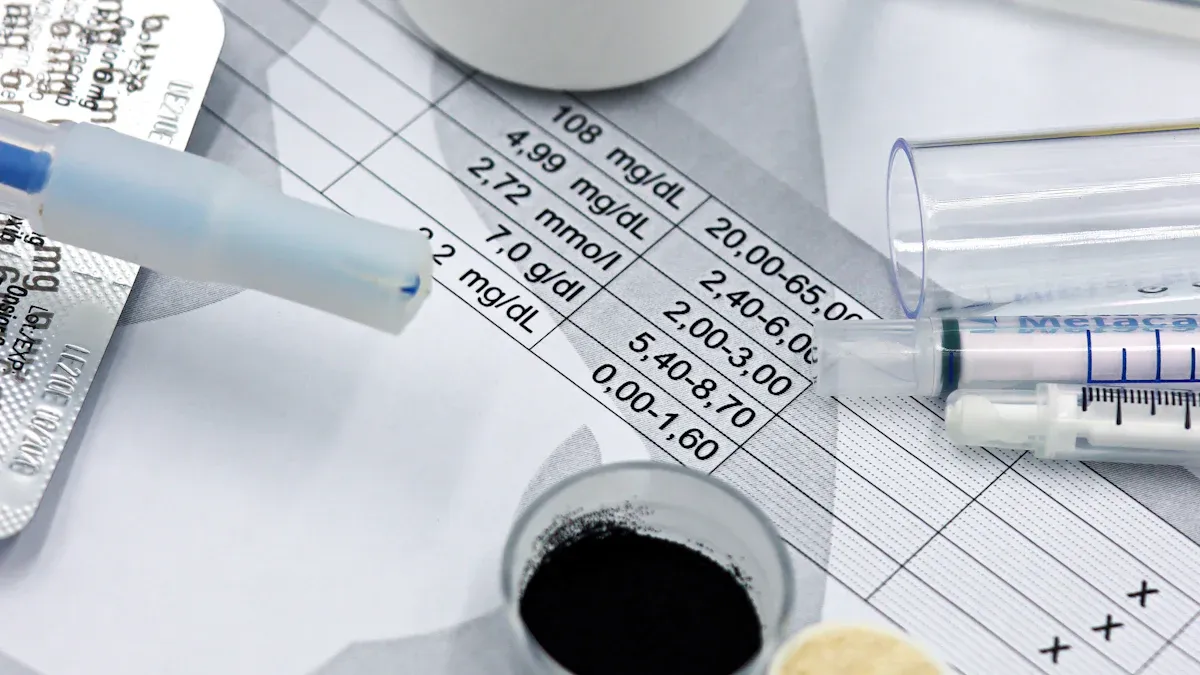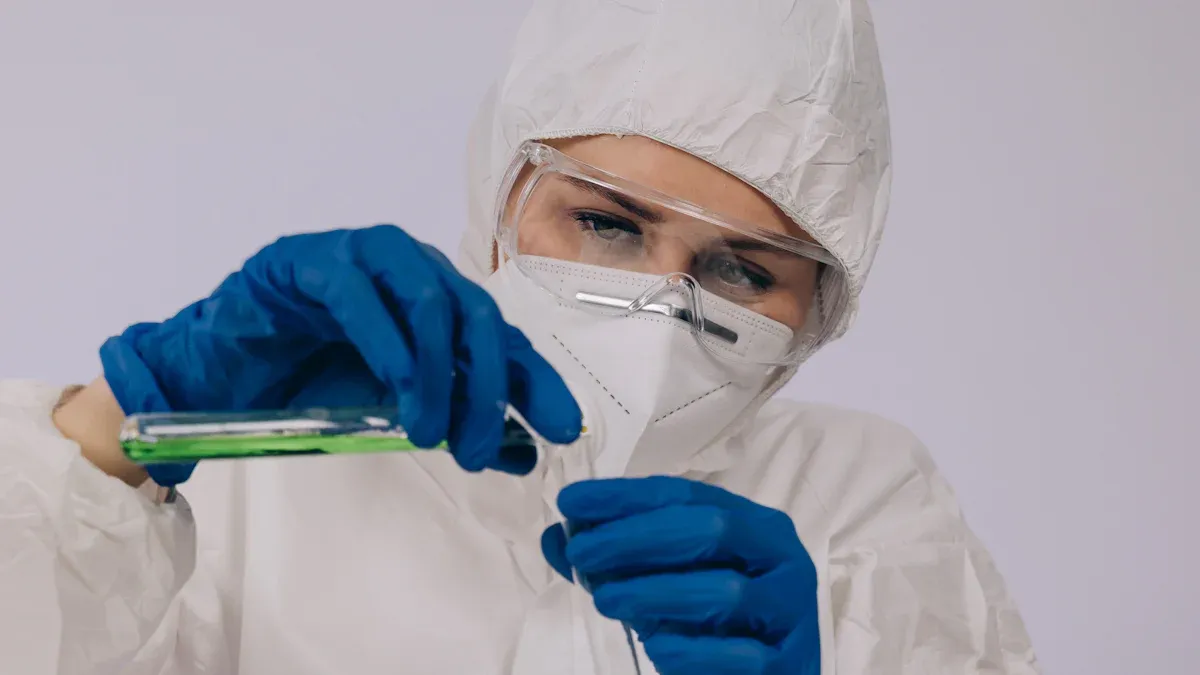
You must handle battery electrolyte solutions for lithium battery packs with precision. Use only approved materials and maintain strict safety protocols. Common errors, such as using tap water or incorrect chemicals, can damage cells and create hazards. Following best practices protects your investment and extends operational life.
Key Takeaways
Always use battery-grade, anhydrous chemicals for preparing electrolyte solutions. This ensures safety and optimal performance.
Avoid using tap water or unapproved chemicals in electrolyte solutions. Impurities can lead to battery failure and safety hazards.
Follow strict safety protocols, including wearing personal protective equipment and working in a well-ventilated area, to protect yourself during preparation.
Part 1: Battery Electrolyte Solutions

1.1 Composition
You need to understand the precise composition of battery electrolyte solutions to ensure optimal performance and safety in lithium battery packs. The electrolyte solution acts as the medium for lithium ions to move between the anode and cathode during charge and discharge cycles. In commercial lithium-ion batteries, the electrolyte solution typically consists of a lithium salt dissolved in a blend of organic solvents. The most common lithium salt is lithium hexafluorophosphate (LiPF6), chosen for its high ionic conductivity and electrochemical stability. Other salts, such as lithium tetrafluoroborate (LiBF4) and lithium perchlorate (LiClO4), may be used in specific scenarios to enhance low-temperature performance or improve safety.
Below is a table summarizing the main chemical components found in commercial battery electrolyte solutions:
Component Type | Examples |
|---|---|
Lithium Salts | LiPF6, LiBF4, LiClO4 |
Organic Solvents | Ethylene carbonate, Diethyl carbonate, Dimethyl carbonate, Ethyl methyl carbonate, Propylene carbonate, Methyl formate, Methyl acrylate, Methyl butylate, Ethyl acetate |
You must use only high-purity lithium salts and solvents. Impurities or incorrect chemicals can compromise the electrolyte solution, leading to poor battery performance or even hazardous conditions.
1.2 Importance
The battery electrolyte serves as the lifeblood of lithium battery packs. It enables the movement of lithium ions, which is essential for energy storage and release. The choice and proportion of lithium salt and organic solvents directly affect the viscosity, ionic conductivity, and wettability of the electrolyte solution. These factors determine how efficiently your battery operates and how long it will last.
Aspect | Effect on Battery Performance |
|---|---|
Electrolyte Viscosity | Higher viscosity slows capillary infiltration, causing dry spots and non-uniform wetting, which harms performance. |
Ionic Conductivity | Optimal conductivity occurs at around 1 M salt concentration, balancing charge carriers and mobility. |
Wettability | Good wettability ensures effective interaction with electrodes, boosting efficiency. |
You should aim for an electrolyte solution with high conductivity and low viscosity. The standard concentration for lithium salt in the electrolyte solution is 1 M, which maximizes bulk conductivity. Selecting the right lithium salt is crucial. For example, LiPF6 offers excellent conductivity and stability but has thermal stability issues and is sensitive to moisture. LiBF4, while less conductive, can improve low-temperature performance and reduce resistance. Your choice of salt will impact both safety and efficiency.
Tip: Always use only distilled water when preparing battery acid for lead-acid batteries. For lithium battery packs, never introduce water into the electrolyte solution, as moisture can trigger dangerous reactions.
1.3 Common Mistakes
Many users make critical errors when preparing or handling battery electrolyte solutions. One frequent mistake is substituting distilled water with tap water or saltwater when mixing battery acid for lead-acid batteries. Tap water contains chlorine and minerals that can corrode internal components, cause sediment buildup, and drastically shorten battery lifespan. In lithium battery packs, introducing water or using impure chemicals in the electrolyte solution can lead to catastrophic failures.
Risk Type | Description |
|---|---|
Corrosion | Chlorine in tap water corrodes internal plates, reducing battery lifespan. |
Performance | Impurities disrupt chemical processes, lowering efficiency. |
Sediment Buildup | Minerals cause sediment, affecting internal processes. |
Shortened Lifespan | Corrosion and sediment drastically shorten battery life, increasing replacement costs. |
Slow Charging | Impurities slow charge/discharge rates, impacting performance during outages. |
You must avoid using substitutes or shortcuts when preparing battery acid or electrolyte solution. Impurities in the electrolyte solution can cause thermal runaway, a dangerous condition where the battery overheats and may catch fire. Water impurities and improper drying of electrodes before assembly can trigger self-heating at lower temperatures, increasing the risk of failure.
⚠️ Note: Never use tap water, saltwater, or any unapproved chemicals in battery electrolyte solutions. Always follow manufacturer guidelines and use only specified materials.
By understanding the correct composition, recognizing the importance of each component, and avoiding common mistakes, you ensure the safety, efficiency, and longevity of your lithium battery packs.
Part 2: High Safety Preparation Steps

2.1 Materials Needed
To achieve high safety standards when preparing battery electrolyte solutions for lithium battery packs, you must select only battery-grade, anhydrous chemicals. Impurities or moisture can compromise both performance and safety. Always verify the purity of your materials and use specialized equipment to measure water content. The following table outlines the essential materials and their specifications:
Essential Material | Specification |
|---|---|
Battery-grade anhydrous chemicals | Required for electrolyte preparation |
Water content | H₂O ≤ 20 ppm recommended to minimize variation |
Container materials | Inert materials like polypropylene (PP), polyethylene (PE), or aluminum (Al) |
Container characteristics | Must be airtight and lighttight for sensitive compounds |
Ensure chemical purity for all materials.
Pre-dry hydrous chemicals to prevent water contamination.
Use the Karl Fischer titration method for accurate water content measurement.
Avoid glass containers, as they can react with LiPF₆ and degrade the electrolyte.
You must always use distilled water when required, as minerals and impurities in tap water can cause corrosion, reduce efficiency, and shorten battery lifespan. This is especially critical for lithium-ion, LiFePO4, NMC, LCO, LMO, LTO, solid-state, and lithium-metal batteries, which are widely used in Medical, Robotics, Security System, Infrastructure, Consumer Electronics, and Industrial applications.
Tip: Never substitute distilled water with tap water or any other unapproved liquid. Even trace minerals can disrupt the chemical balance and lead to premature battery failure.
2.2 Mixing Process
You must follow a precise mixing process to ensure high safety and optimal electrolyte performance. Begin by preparing your workspace in a cool, dry, and well-ventilated area. This reduces the risk of overheating and hazardous reactions. Always label your chemicals and segregate battery types to avoid cross-contamination.
Measure the lithium salt and organic solvents according to your battery chemistry requirements.
For lithium-ion batteries, maintain a standard concentration of 1 M for lithium salt in the solvent blend.
If you use concentrated electrolytes, you can achieve safe operation from −20°C to 100°C, which is broader than the conventional range of −20°C to 55°C. For example, a 4.0 mol L⁻¹ LiN(SO₂F)₂/dimethyl carbonate electrolyte supports stable cycling across this range.
Add the lithium salt slowly to the solvent while stirring gently. This prevents localized overheating and ensures uniform dissolution.
Use only inert containers made of PP, PE, or Al. Avoid glass, as it can react with certain lithium salts and compromise safety.
Note: Concentrated electrolytes can enhance both safety and performance, especially in demanding environments like Industrial or Infrastructure applications.
2.3 Safety Precautions
You must prioritize safety at every stage of electrolyte preparation. Personal protective equipment (PPE) is essential when handling hazardous chemicals such as sulfuric acid or lithium salts. The following table summarizes the recommended PPE:
Personal Protective Equipment | Description |
|---|---|
Safety Goggles or Face Shield | Protects your eyes from accidental splashes |
Acid-resistant Gloves | Shields your hands from acid burns |
Protective Clothing | Prevents skin contact with hazardous substances |
Respirator | Prevents inhalation of harmful vapors |
Always work in a well-ventilated area to avoid inhaling fumes.
Store chemicals in airtight, lighttight containers to prevent degradation.
Regularly train all personnel on safety protocols and emergency procedures.
Label all containers clearly and segregate different battery chemistries.
OSHA regulations require you to handle battery electrolyte solutions in a controlled environment. Proper labeling, segregation, and use of safety equipment are mandatory for high safety standards.
2.4 Epsom Salt Method
The Epsom salt method offers a practical solution for reviving lead-acid batteries, which are still used in some backup and Industrial systems. This method uses magnesium sulfate (Epsom salt) to reduce sulfur crystal buildup on lead plates, restoring battery function in up to 90% of cases.
Dissolve Epsom salt in distilled water to create the solution.
Add the solution to each battery cell, replacing the old electrolyte.
Charge the battery slowly to allow the magnesium sulfate to react with the lead sulfate.
Magnesium sulfate and lead sulfate undergo a single replacement reaction. Magnesium, being more reactive than lead, replaces it in the plates, helping to dissolve the sulfate crystals.
While this method can rejuvenate many dead batteries, it may not work for those with severe damage or deep-seated sulfation. Always use only distilled water to avoid introducing minerals that can coat the plates, reduce efficiency, and cause corrosion.
Minerals like calcium and magnesium can create deposits on internal plates, impeding electron flow and reducing capacity.
Iron and chlorides can corrode the internal structure, shortening operational life.
Impurities can interfere with chemical processes, leading to scale buildup and even short-circuiting.
⚠️ Always dispose of used electrolyte materials responsibly. Improper disposal can contaminate soil, pollute water, and harm both ecosystems and human health.
By following these high safety preparation steps, you protect your lithium battery packs and ensure reliable performance in critical applications.
You ensure battery longevity and safety by using only approved materials and following strict protocols.
Always select battery-grade chemicals and maintain proper charging methods.
Understand specific requirements for each lithium battery type.
Safety Standard | Impact on Lifespan and Performance |
|---|---|
Reduces risk, enhances reliability |
Regular maintenance and avoiding shortcuts protect your investment.
FAQ
1. What is the safest way to prepare electrolyte solutions for lithium battery packs?
You should use battery-grade chemicals, inert containers, and strict safety protocols. Large Power recommends custom battery consultation for your specific lithium battery pack needs.
2. Can you use the same electrolyte for solid-state lithium metal batteries and lithium-ion batteries?
No. Solid-state lithium metal batteries require specialized electrolytes for stability and compatibility with lithium metal anodes. Learn more about solid-state lithium batteries.
3. How do you select the right electrolyte for next-generation energy storage systems?
You must analyze your application scenario, energy density, and cycle life requirements. Large Power offers tailored solutions for next-generation energy storage systems.




